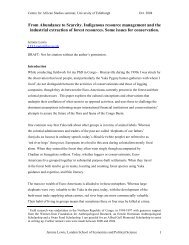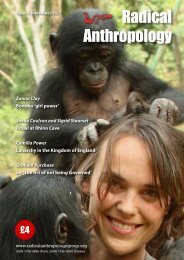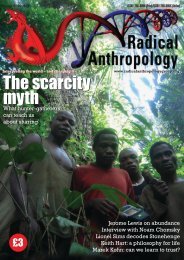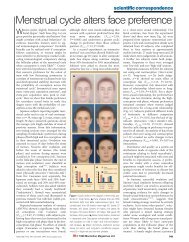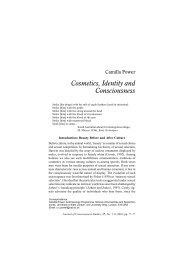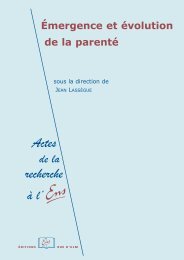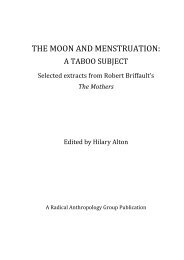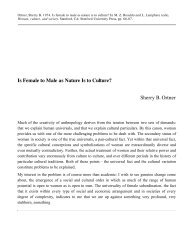Language and life history: A new perspective on the development ...
Language and life history: A new perspective on the development ...
Language and life history: A new perspective on the development ...
- No tags were found...
Create successful ePaper yourself
Turn your PDF publications into a flip-book with our unique Google optimized e-Paper software.
Resp<strong>on</strong>se/Locke & Bogin: <str<strong>on</strong>g>Language</str<strong>on</strong>g> <str<strong>on</strong>g>and</str<strong>on</strong>g> <str<strong>on</strong>g>life</str<strong>on</strong>g> <str<strong>on</strong>g>history</str<strong>on</strong>g>first type of trade-off is competiti<strong>on</strong> between organs ortissues of <strong>the</strong> body during growth. For example, shouldenergy <str<strong>on</strong>g>and</str<strong>on</strong>g> materials be devoted to growing a large setof muscles or a larger brain? An example of <strong>the</strong> sec<strong>on</strong>dtype of trade-off is <strong>the</strong> choice of producing <strong>on</strong>e large offspring(k-selecti<strong>on</strong>) or many, smaller offspring (r-selecti<strong>on</strong>;cf. Wils<strong>on</strong> 1980). All living things face <strong>the</strong>se trade-offdecisi<strong>on</strong>s. Some occur <strong>on</strong> a day-to-day basis, o<strong>the</strong>rsoccur over l<strong>on</strong>ger periods of time. Those that have reproductivec<strong>on</strong>sequences <str<strong>on</strong>g>and</str<strong>on</strong>g> occur over generati<strong>on</strong>s aresubject to natural selecti<strong>on</strong>, <str<strong>on</strong>g>and</str<strong>on</strong>g> <strong>the</strong> effected traits mayevolve over time.Had we discussed trade-offs, we might have forestalled<strong>the</strong> comment of Johanss<strong>on</strong>, Zlatev, & Gärdenfors(Johanss<strong>on</strong> et al.) that our model does not “explain <strong>the</strong>absence of language in, for example, chimpanzees”(emphasis in original; also see sect. R9). Chimpanzeeshave taken <strong>on</strong>e path in <str<strong>on</strong>g>life</str<strong>on</strong>g> <str<strong>on</strong>g>history</str<strong>on</strong>g> trade-offs, <str<strong>on</strong>g>and</str<strong>on</strong>g> itincludes a l<strong>on</strong>g period of nursing of infants to ensure survivalversus more rapid reproducti<strong>on</strong>, in <strong>the</strong> hope thatsome offspring survive (also see <strong>the</strong> final paragraph ofsect. 2.7 in <strong>the</strong> target article). Human ancestors evolvedcooperative breeding to have both more offspring <str<strong>on</strong>g>and</str<strong>on</strong>g>more survival, but with a trade-off cost in terms of socialinteracti<strong>on</strong>. That cost entails getting individuals withselfish interests to cooperate. Our model proposes thathuman ancestors intensified <strong>the</strong> use of h<strong>on</strong>est signaling,<strong>the</strong> use of communicative displays such as smiles, <str<strong>on</strong>g>and</str<strong>on</strong>g>eventually language as a means to reduce social c<strong>on</strong>flict<str<strong>on</strong>g>and</str<strong>on</strong>g> foster cooperati<strong>on</strong>.Bjorklund & Grotuss pick up <strong>the</strong> <strong>the</strong>me of evoluti<strong>on</strong>arytrade-offs in <strong>the</strong>ir commentary. They refer to <strong>development</strong>alplasticity, ano<strong>the</strong>r important c<strong>on</strong>cept <str<strong>on</strong>g>and</str<strong>on</strong>g> mechanismthat we do not menti<strong>on</strong> in our target article but have discussedat some length elsewhere (Bogin 1999b; Locke1997). Bjorklund & Grotuss’s propositi<strong>on</strong> that language isa product of childhood plasticity in “sociocognitive abilities”is entirely c<strong>on</strong>sistent with <strong>the</strong> message of our article. Wethank <strong>the</strong>m for providing ano<strong>the</strong>r important way to lookat <strong>the</strong> questi<strong>on</strong> of <strong>the</strong> evoluti<strong>on</strong> of language.The commentaries of Bright<strong>on</strong>, Mata, & Wilke(Bright<strong>on</strong> et al.) <str<strong>on</strong>g>and</str<strong>on</strong>g>ofPowers point to ano<strong>the</strong>r omissi<strong>on</strong>in our article, namely, <strong>the</strong> importance of ma<strong>the</strong>maticalmodeling. Much of <str<strong>on</strong>g>life</str<strong>on</strong>g> <str<strong>on</strong>g>history</str<strong>on</strong>g> <strong>the</strong>ory ispredicated <strong>on</strong> ma<strong>the</strong>matical models (e.g., Bogin 1988;Charnov 1993; Gage 1998; Gurven & Walker 2006;Kaplan et al. 2000; Stearns 1992;). Modeling adds clarityof c<strong>on</strong>ceptualizati<strong>on</strong>, delineates <strong>the</strong> variables <str<strong>on</strong>g>and</str<strong>on</strong>g> parametersto be c<strong>on</strong>sidered, <str<strong>on</strong>g>and</str<strong>on</strong>g> offers <strong>on</strong>e type of scientifictestability. Modeling is akin to inductive reas<strong>on</strong>ing,whereas <strong>the</strong> approach we take in our article combinesdeductive <str<strong>on</strong>g>and</str<strong>on</strong>g> inductive reas<strong>on</strong>ing. We nei<strong>the</strong>rdisagree with our critics nor do we grant <strong>the</strong>ir approachprimacy.Kaplan et al. (2000) <str<strong>on</strong>g>and</str<strong>on</strong>g> Gurven <str<strong>on</strong>g>and</str<strong>on</strong>g> Walker (2006) aretwo excellent examples of modeling human <str<strong>on</strong>g>life</str<strong>on</strong>g> <str<strong>on</strong>g>history</str<strong>on</strong>g>, notmenti<strong>on</strong>ed by any of <strong>the</strong> commentators. Kaplan <str<strong>on</strong>g>and</str<strong>on</strong>g> colleaguesshow that human <str<strong>on</strong>g>life</str<strong>on</strong>g> <str<strong>on</strong>g>history</str<strong>on</strong>g> differs from <strong>the</strong> <str<strong>on</strong>g>life</str<strong>on</strong>g><str<strong>on</strong>g>history</str<strong>on</strong>g> of <strong>the</strong> chimpanzee in several key dimensi<strong>on</strong>s.Based <strong>on</strong> empirical research with living human foragingsocieties, <strong>the</strong>y show ma<strong>the</strong>matically that adults must provisi<strong>on</strong>human offspring for about 15 years. Until that age<strong>the</strong> young cannot produce enough food to meet <strong>the</strong>irown energetic dem<str<strong>on</strong>g>and</str<strong>on</strong>g>s. The need for such lengthyprovisi<strong>on</strong>ing requires <strong>the</strong> type of close, cooperative,h<strong>on</strong>est, <str<strong>on</strong>g>and</str<strong>on</strong>g>, at times, deceptive social c<strong>on</strong>tact that isboth a human defining trait <str<strong>on</strong>g>and</str<strong>on</strong>g> facilitated by symboliclanguage <str<strong>on</strong>g>and</str<strong>on</strong>g> human cultural behavior (Gurven et al.2000). We also note that <strong>the</strong> provisi<strong>on</strong>ing of young <str<strong>on</strong>g>and</str<strong>on</strong>g><strong>the</strong>ir language <strong>development</strong> takes nearly all of human<strong>on</strong>togeny prior to reproductive age. This is not likely tobe a coincidence.Gurven <str<strong>on</strong>g>and</str<strong>on</strong>g> Walker (2006) build <strong>on</strong> Bogin’s <str<strong>on</strong>g>life</str<strong>on</strong>g> <str<strong>on</strong>g>history</str<strong>on</strong>g>model. They use computer simulati<strong>on</strong>s inductively to showthat slow childhood <str<strong>on</strong>g>and</str<strong>on</strong>g> juvenile growth allows for <strong>the</strong> typeof food provisi<strong>on</strong>ing that defines human cooperativebreeding. Moreover, Gurven <str<strong>on</strong>g>and</str<strong>on</strong>g> Walker’s modelingshows that slow “growth followed by a rapid adolescentgrowth spurt may have facilitated rising human fertilityrates <str<strong>on</strong>g>and</str<strong>on</strong>g> greater investments in neural capital.”A fundamental distincti<strong>on</strong> in approaches taken in <str<strong>on</strong>g>life</str<strong>on</strong>g><str<strong>on</strong>g>history</str<strong>on</strong>g> research is clarified by <strong>the</strong> work of ma<strong>the</strong>maticalmodelers such as Gould (1977) <str<strong>on</strong>g>and</str<strong>on</strong>g> McKinney (2000),cited in some commentaries, as well as Charnov (1993)<str<strong>on</strong>g>and</str<strong>on</strong>g> Gage (1998), who were not cited by any of our resp<strong>on</strong>dents.Gould <str<strong>on</strong>g>and</str<strong>on</strong>g> McKinney employ models based <strong>on</strong> heterochr<strong>on</strong>y,which is an evoluti<strong>on</strong>ary process that alters <strong>the</strong>timing of existing <str<strong>on</strong>g>life</str<strong>on</strong>g> <str<strong>on</strong>g>history</str<strong>on</strong>g> stages. The heterochr<strong>on</strong>ymodel for human evoluti<strong>on</strong> holds that <strong>the</strong> existing <str<strong>on</strong>g>life</str<strong>on</strong>g>stages of human primate ancestors were leng<strong>the</strong>ned toderive <strong>the</strong> human c<strong>on</strong>diti<strong>on</strong> (McKinney & McNamara1991). This is, essentially, <strong>the</strong> basis for <strong>the</strong> c<strong>on</strong>tinuitymodel for primate biology presented in <strong>the</strong> commentariesalready discussed. Heterochr<strong>on</strong>y does have its place in <str<strong>on</strong>g>life</str<strong>on</strong>g><str<strong>on</strong>g>history</str<strong>on</strong>g> evoluti<strong>on</strong>, but we have found it lacking for humanevoluti<strong>on</strong>. We have reviewed <strong>the</strong> literature both for <str<strong>on</strong>g>and</str<strong>on</strong>g>against heterochr<strong>on</strong>y <str<strong>on</strong>g>and</str<strong>on</strong>g> offered <str<strong>on</strong>g>new</str<strong>on</strong>g> empirical evidence– using our inductive approach – against heterochr<strong>on</strong>y(Bogin 1997; 1999a; 1999b). Instead, we found evidencesupporting <strong>the</strong> inserti<strong>on</strong> of <strong>the</strong> novel <str<strong>on</strong>g>life</str<strong>on</strong>g> <str<strong>on</strong>g>history</str<strong>on</strong>g> stages ofchildhood <str<strong>on</strong>g>and</str<strong>on</strong>g> adolescence into human <strong>development</strong>.The inserti<strong>on</strong> of childhood shortened <strong>the</strong> infancy stage<str<strong>on</strong>g>and</str<strong>on</strong>g> <strong>the</strong> juvenile stage of o<strong>the</strong>r primate species. Theinserti<strong>on</strong> of adolescence did leng<strong>the</strong>n <strong>the</strong> time to adulthood,but not by leng<strong>the</strong>ning any pre-existing <str<strong>on</strong>g>life</str<strong>on</strong>g> <str<strong>on</strong>g>history</str<strong>on</strong>g>stage. The inductive model <strong>the</strong>orists Charnov <str<strong>on</strong>g>and</str<strong>on</strong>g> Gagesupport our view. Charnov finds that <strong>the</strong> <str<strong>on</strong>g>life</str<strong>on</strong>g> histories ofmost species of fish, insects, <str<strong>on</strong>g>and</str<strong>on</strong>g> mammals studied canbe modeled with his invariant <str<strong>on</strong>g>life</str<strong>on</strong>g> <str<strong>on</strong>g>history</str<strong>on</strong>g> symmetries.The glaring excepti<strong>on</strong> is <strong>the</strong> species of Order Primates,especially Homo sapiens. Gage used both ma<strong>the</strong>maticalmodeling <str<strong>on</strong>g>and</str<strong>on</strong>g> empirical data to c<strong>on</strong>trast chimpanzee <str<strong>on</strong>g>and</str<strong>on</strong>g>human <str<strong>on</strong>g>life</str<strong>on</strong>g> <str<strong>on</strong>g>history</str<strong>on</strong>g> with regard to demography. He findsthat <strong>the</strong>se two most genetically similar primates are quitedivergent. Chimpanzees have a l<strong>on</strong>ger reproductive <str<strong>on</strong>g>life</str<strong>on</strong>g>span than humans, due to both <strong>the</strong> later <strong>on</strong>set of fertility<str<strong>on</strong>g>and</str<strong>on</strong>g> menopause of human women (chimpanzee do nothave menopause; see Littlet<strong>on</strong> 2005). Chimpanzeessuffer greater infant mortality than humans. Indeed, chimpanzeemortality is greater at all ages prior to sexual maturati<strong>on</strong>.Human demography is unstable, meaning <strong>the</strong>re ismore variability in both mortality <str<strong>on</strong>g>and</str<strong>on</strong>g> fertility am<strong>on</strong>ghumans than am<strong>on</strong>g chimpanzees. Humans are anunusual primate species for having “baby booms.” Gagesuggests that <strong>the</strong>se fertility booms may have played animportant role in <strong>the</strong> evoluti<strong>on</strong> of human culture.Finally, <strong>the</strong> <str<strong>on</strong>g>life</str<strong>on</strong>g> <str<strong>on</strong>g>history</str<strong>on</strong>g> pattern of <strong>the</strong> human speciesdepends <strong>on</strong> low pre-reproductive mortality. This novel304 BEHAVIORAL AND BRAIN SCIENCES (2006) 29:3



